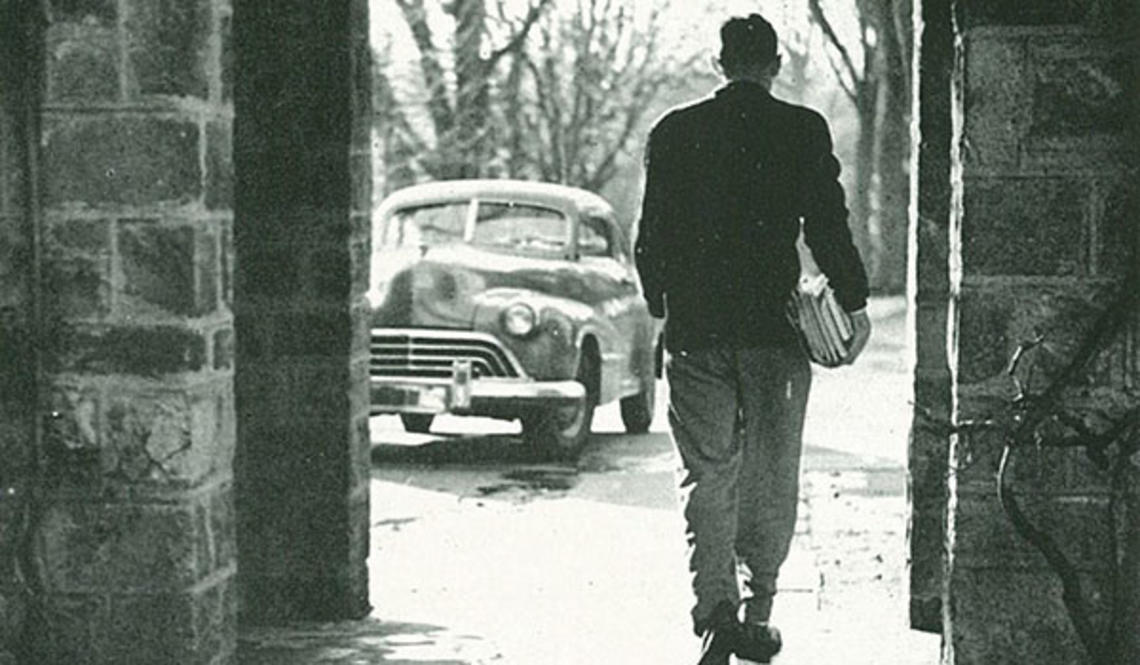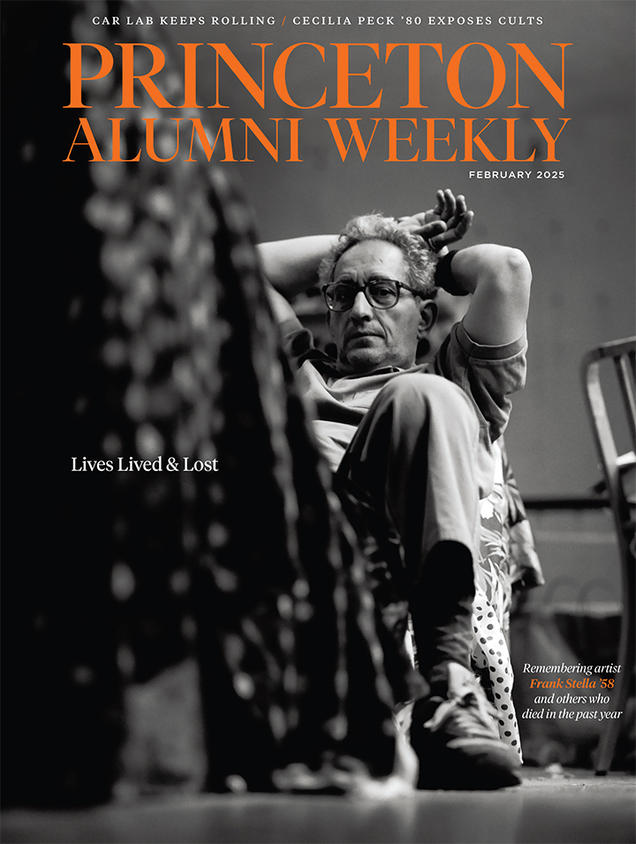
In this episode, we look at a decades-old issue that’s back in the news: students’ cars on campus. Also, Gregg tips his hat to two of Princeton’s most accomplished coaches, Peter Farrell and Fred Samara.
The Rally ’Round the Cannon podcast is also available on iTunes — click here to subscribe
TRANSCRIPT
BT: I’m Brett Tomlinson, the digital editor of the Princeton Alumni Weekly.
GL: And I’m Gregg Lange of the Great Class of 1970, who really should know better.
BT: And this is the Rally ’Round the Cannon Podcast, a podcast about Princeton’s history. It’s so often the case around here that things that we see in the news in PAW are actually stories that we saw many years ago. One that comes to mind— Well, at Reunions, I get to do these oral history interviews with alumni, and a few years back we talked to members of the Class of 1962, and I made the mistake of saying that things must have been different for you because you didn’t have cars on campus. And the reply from many of the people I spoke with was, you think we didn’t have cars. Apparently there were a lot of ways to get a car, to get permission to have a car. One of the folks I talked to was Barry Bosak, the ’62 class secretary, and he talked about using his thesis research as an excuse to get car permission. His adviser was signing the application allowing him to travel back and forth to Cornell, and he said, “Barry, what’s her name?” So he was very clear on the idea that this was not for the thesis, this was so he could go see his then-girlfriend and eventually his wife.
This idea of getting permission to have a car on campus is back in the news because what used to be a privilege for juniors and seniors is now something that will be reserved for folks who have a “compelling need” to have a car on campus. That is the new rule for students. There was quite a bit of outcry about that, but cars on campus for students is an issue that goes back almost as long as there were cars. Gregg, I know you have some thoughts on that – not just parking but driving and the whole issue of cars for students.
GL: And we won’t even address the WPRB station car, which is how my classmate Gregg Petsko got his car on campus. Of course the cost to him was steep since we used it to drive all over the northeast to do play by play for football and basketball broadcasts. He paid a steep price to have it available the rest of the time, but very much the same as your story.
Anyway, I think there are folks from my era, and the 70s and early in the 80s, who are actually surprised that the restrictions to freshmen and sophomores have crept back in. Part of the great revolution of the late 60s was to get rid of the car rule, and of course you had to pay to register and park it on campus, but that was a fairly minor trial compared to all of this paperwork that you described, and trying to come up with an excuse to have a car there. These days, kids driving cars to high school happens all the time, and then to be stuck with a paperwork requirement freshman and sophomore years at a place like Princeton is quite fascinating, actually. The fact that’s crept back in over the decades is interesting enough. The fact that the administration is trying to expand it to juniors and seniors and throw the majority of people back on the dinky again is actually really really fascinating.
That would put it almost exactly where it was in 1968, the circumstance you just described. That had pertained with no break for 40 years at that point, 90 years ago now, when the president and the trustees – John Grier Hibben was the president at that point, and I will remind you that he was the last ordained minister to be the president of Princeton, which shouldn’t get lost in the shuffle – had spent years building new dorms to try to get all the students onto campus where they could keep their eye on them, and away from the public, with the semi-moralistic explanation that that was probably a better influence on the students and a better influence on the public both, which certainly has some defensible aspects to it. Anyway, beyond that, in 1927 they just flat out forbade students to have cars on campus. Technically you did need an excuse, but at that point the excuse had to be something akin to your mother being on an iron lung somewhere, and not to go visit your girlfriend at Cornell and stop by the library while you were around.
BT: To be fair, it does sound like there will be quite a few ways that you can demonstrate that compelling need. There’s a whole list of things to justify having a car on campus but it’s definitely adding a restriction that was not there previously and had not been there for many years.
GL: The other two things I would note about it is that after it got started in 1927, it gained a real lock on administrative procedure at Princeton, in part because of two major incidents. One was a year afterwards, when Stockwell Jadwin, one of the class of 1928, who had been captain of the track team, died in an auto accident just a few months after he graduated, which hit the University very hard. And then when Hibben himself retired in 1932, since he was leaving Prospect and his home in the middle of campus, the trustees with a great flourish and an irony that was noted by the students by the way, gave Hibben a beautiful automobile. He and his wife both were killed in an auto accident in that car less than a year later. If nothing else, those incidents solidified the whole attitude of the campus and the Dodds’ administration subsequently against cars. The issue really never came up again heavily until the 60s when it finally overcame objections. It’s been a fight for 90 years and obviously it’s going to keep going.
BT: You mentioned L. Stockwell Jadwin, and another story in the June issue is about a coach that has had an office in Jadwin Gym for the last 39 years, Peter Farrell. He built the women’s cross country and track programs. He’s been their only head coach, and he is retiring – a remarkable record for Peter. We have a story in the magazine, and we have another piece online that captures a bit of his personality and what has made him such an influential coach over these years. But it’s not just Peter – both track programs have had amazing stability and success.
GL: One technical detail I was not aware of until I read this issue of PAW was that Peter and Fred Samara, who has been the head coach of men’s track and field for 33 years, since ’82 now, actually were hired within a week of each other in 1977, which is semi-hilarious in that what they’ve done jointly is so indescribably singular. Peter has won 27 Ivy League championships, equally divided among indoor track, outdoor track, and cross country with the women. Fred has actually won 38 Ivy League championships in his 33 years, including 19 indoor titles, which is actually hard to believe at this point in 33 years in a very competitive league. The two of them are great friends, wonderful mutual supporters. The men’s and women’s track teams always are fabulously supportive of one another.
Ironically the main thing that stood in the way of Princeton track and field for many years was the indoor facility. By the 60s Princeton was doing most of its indoor track competitions at the Lawrenceville School, which had a far superior facility to anything Princeton had. Princeton was still using the armory when Mrs. Stanley Jadwin died in 1966. All of a sudden, the chance rose to change that, along with a number of other purposes in the athletic department. Her unrestricted gift – she was Stockwell Jadwin’s mother – allowed the University to build Jadwin Gym, which was designed by Ken Fairman of the Class of ’34, who was the athletic director at the time. Princeton all of a sudden went from essentially nothing to the best indoor track in the Ivy League at that point, and one which has really remained a fabulous facility because of the unique way the Jadwin is designed. That allowed Princeton to become a real 12-month a year track location.
The success of Peter and Fred in turn, when the new Princeton stadium was built, persuaded the University to really go big time on the new Weaver track and field south of the new stadium, which is again as magnificent a facility in the college game as you can find. The combination of those over the years has done great service to the University and to the students who have participated in track and field, and in turn they have been treated to the best coaching on the planet as far as I can see from Fred and Peter. To say that Peter deserves a nice comfortable rest after 38 years of doing this is probably the biggest understatement we can find. God bless him and everything he’s done. I don’t know how in heaven’s name they’ll ever replace him, but fortunately that’s not my problem.
BT: I think we’ve touched on the things we wanted to cover in this episode. Gregg, would you like to say a few words about your Rally ’Round the Cannon column this time?
GL: We’re going directly for the semantic this time. For those of you who have gotten tired of substance, this is for you. Anyway, Princeton has a new unofficial motto, whether or not you know that. You’re welcome to go to the Rally ’Round the Cannon column on the online PAW and take a good solid look at various options that we might or might not realistically have. I would also call to your attention, in the print edition as well, the letter to the editor by Bill Holmer of the Great Glass of ’68 who actually comes up with a marvelous and wildly elegant suggestion simply by the dint of using punctuation, which you have to take off your hat and admire if only because of the lovely understated nature of it. Good for you, Bill. I’ve got a few other more obvious suggestions in my column. Have a good time. Put up some comments online if you come up with something better or if you really dislike something I put up, and we’ll have a good time.
BT: I’ll remind our listeners that Rally ’Round the Cannon is a podcast from the Princeton Alumni Weekly online.
GL: Thanks so much.

